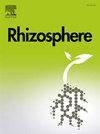The root extracellular trap: A checkpoint controlling root tip accessibility to microorganisms
IF 3.4
3区 生物学
Q1 PLANT SCIENCES
引用次数: 0
Abstract
The root tip and root-Associated Cap-Derived Cells (AC-DCs) release various organic compounds into the rhizosphere, forming the Root Extracellular Trap (RET), a network involved in root-soil microorganism interactions and root protection. This study investigates the role of soybean (Glycine max) and pea (Pisum sativum) RETs in interactions with soil rhizobacteria (Bacillus subtilis and Pseudomonas fluorescens) and the zoospores of the oomycete Phytophthora parasitica by examining their impact on microbial behavior. To this end, confrontation tests were performed, followed by imaging analyses of videos, in which the behavior of microorganisms (i.e., swimming speeds and trajectories) was characterized and quantified. The results show that the RET alters microbial access to the root tip and modifies significantly speeds and trajectories. Inside the RET, the speeds of B. subtilis and P. parasitica zoospores decreased three and nine times respectively. Outside the RET, the speed of the bacterium remains unchanged, while that of the zoospores decreases twice. These findings highlight the influence of the RET on microbial movement and its importance in plant-microorganism interactions in the rhizosphere.
求助全文
约1分钟内获得全文
求助全文
来源期刊

Rhizosphere
Agricultural and Biological Sciences-Agronomy and Crop Science
CiteScore
5.70
自引率
8.10%
发文量
155
审稿时长
29 days
期刊介绍:
Rhizosphere aims to advance the frontier of our understanding of plant-soil interactions. Rhizosphere is a multidisciplinary journal that publishes research on the interactions between plant roots, soil organisms, nutrients, and water. Except carbon fixation by photosynthesis, plants obtain all other elements primarily from soil through roots.
We are beginning to understand how communications at the rhizosphere, with soil organisms and other plant species, affect root exudates and nutrient uptake. This rapidly evolving subject utilizes molecular biology and genomic tools, food web or community structure manipulations, high performance liquid chromatography, isotopic analysis, diverse spectroscopic analytics, tomography and other microscopy, complex statistical and modeling tools.
 求助内容:
求助内容: 应助结果提醒方式:
应助结果提醒方式:


